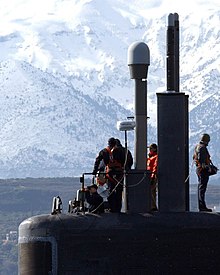Submarine navigation
Submarine navigation underwater requires special skills and technologies not needed by surface ships. The challenges of underwater navigation have become more important as submarines spend more time underwater, travelling greater distances and at higher speed. Military submarines travel underwater in an environment of total darkness with neither windows nor lights. Operating in stealth mode, they cannot use their active sonar systems to ping ahead for underwater hazards such as undersea mountains, drilling rigs or other submarines. Surfacing to obtain navigational fixes is precluded by pervasive anti-submarine warfare detection systems such as radar and satellite surveillance. Antenna masts and antenna-equipped periscopes can be raised to obtain navigational signals but in areas of heavy surveillance, only for a few seconds or minutes;[1] current radar technology can detect even a slender periscope while submarine shadows may be plainly visible from the air.


Navigational technologies
[edit]Surfaced submarines entering and leaving port navigate similarly to traditional ships but with a few extra considerations because most of the boat rides below the waterline, making them hard for other vessels to see and identify. Submarines carry an inertial navigation system, which measures the boat’s motion and constantly updates position. Because it does not rely on radio signals or celestial sightings, it allows the boat to navigate while remaining hidden under the surface. To maintain accuracy, the submarine must periodically update its position using outside navigational radio signals. From the 1960s to the 1990s, Transit satellites and LORAN shore stations provided those signals. GPS has now replaced both.
Surface and near-surface navigation
[edit]On the surface or at periscope depth, submarines have used these methods to fix their position:
- Satellite navigation:
- Global positioning system (GPS)—by entering waypoints internally, able to navigate at a more precise level.
- NAVSAT
- Terrestrial radio-based navigation systems; largely superseded by satellite systems
- LORAN—Low frequency radio hyperbolic navigation system, no longer in use
- CHAYKA, the Russian counterpart of LORAN
- OMEGA, Western very low frequency global-range radio hyperbolic navigation system, no longer in use
- Alpha, the Russian counterpart of the Omega Navigation System
- Celestial navigation using the periscope, or sextant—seldom used anymore due to advancement in technology
- Radar navigation; radar signals are easily detected so radar is normally only used in friendly waters entering and exiting ports. With the implementation of a more advanced radar system, many new techniques have been implemented in this process.
- Active sonar; like radar, active sonar systems are readily detected, so active sonar is usually used only entering and exiting ports.
- Pilotage—in coastal and internal waters, surfaced submarines rely on the standard system of navigational aids (buoys, navigational markers, lighthouses, etc.), utilizing the periscopes for obtaining lines of position to plot a triangulation fix.
- Voyage Management System—referred to as the VMS, utilizes digital charts with other external sources fed in, to establish the ship's position. Other information may also be entered in manually in establishing a high quality fix or position.
Deep water navigation
[edit]At depths below periscope depth submarines determine their position using:
- Dead reckoning course information obtained from the ship's gyrocompass, measured speed and estimates of local ocean currents, this could also be considered an estimated position as long as the ocean current is computed in.
- Inertial navigation system is an estimated position source, utilizing acceleration, deceleration, and pitch and roll for computing.
- Bottom contour navigation may be used in areas where detailed hydrographic data has been charted and there is adequate variation in sea floor topography.[2][3][4] Fathometer depth measurements are compared to charted depth patterns.
See also
[edit]- Bearing (angle) – In navigation, horizontal angle between the direction of an object and another object
- Passive sonar – Acoustic sensing method
- Diver navigation – Underwater navigation by scuba divers
- Underwater acoustic positioning system – System for tracking and navigation of underwater vehicles or divers using acoustic signals
Footnotes
[edit]- ^ Bivens, Arthur Clarke (July 2004). From Sailboats to Submarines. Infinity Publishing. p. 184. ISBN 978-0-7414-2152-4.
- ^ "Lesson 14: Electronic Navigation". Navigation and Operations I. University of Kansas, Naval Reserve Officer Training Corps. pp. Slides 19 to 21. Archived from the original (Microsoft PowerPoint) on September 11, 2006. Retrieved 2007-11-14.
- ^ "2003 CJCS Master Positioning, Navigation, And Timing Plan" (PDF). Joint Chiefs of Staff. p. F-12. Archived from the original (PDF) on 2007-07-05. Retrieved 2007-11-14.
- ^ S. E., Hamn (August 1995). "Coastal piloting: bottom contour navigation.(Seamanship)". Trailer Boats. Retrieved 2007-11-14. [dead link]
References
[edit]- Clancy, Tom; John Gresham (2002-01-08) [1993]. Submarine: A Guided Tour Inside a Nuclear Warship (Revised ed.). Berkley Books. ISBN 978-0-425-18300-7.
- Craven, John Piña (2001). The Silent War: The Cold War Battle Beneath the Sea. New York, New York: Simon & Schuster. ISBN 978-0-684-87213-1.
- DiMercurio, Michael; Michael Benson (23 December 2002). Complete Idiot's Guide to Submarines. Indianapolis, Indiana: Alpha Books. ISBN 978-0-02-864471-4.
- Harris, Brayton (1997). Navy Times Book of Submarines (1st ed.). New York, New York: Berkley Hardcover. ISBN 978-0-425-15777-0.
- Hutchinson, Robert (2001). Jane's Submarines: War Beneath the Waves from 1776 to the Present Day. HarperCollins Publishers. ISBN 978-0-06-081900-2.
- Leary, William M. (1999). Under Ice: Waldo Lyon and the Development of the Arctic Submarine (1st ed.). College Station, Texas: Texas A&M University Press. ISBN 978-0-89096-845-1.
- Miller, David (1987). Modern Submarine Warfare (1st ed.). Crescent. ISBN 978-0-517-64647-2.
- Parrish, Tom (2004). The Submarine: A History. New York, New York: Viking Penguin. ISBN 978-0-670-03313-3.
- Preston, Antony (1999). Submarine Warfare: An Illustrated History. San Diego, California: Thunder Bay Press. ISBN 978-1-57145-172-9.
- van der Vat, Dan (1995). Stealth at Sea: The History of the Submarine. Houghton Mifflin. ISBN 978-0-395-65242-8.
- Waller, Douglas C. (March 2001). Big Red: Three Months on Board a Trident Nuclear Submarine. HarperCollins Publishers. ISBN 978-0-06-019484-0.
